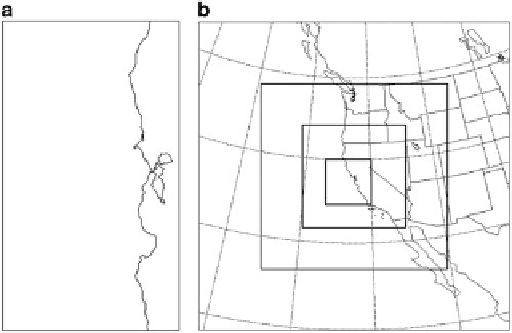Geoscience Reference
In-Depth Information
Fig. 16.1
The NCOM and NCODA domain; (
b
) The COAMPS nested domain
and domain setting are exactly the same in both studies. The ocean model is
the Navy Coastal Ocean Model (NCOM,
Martin 2000
) with the multivariate
analysis of Navy Coupled Ocean Data Assimilation (NCODA,
Cummings 2005
).
The atmospheric forcing is obtained from a deterministic operational forecast
using Coupled Ocean/Atmosphere Mesoscale Prediction System (COAMPS,
Doyle
et al. 2008
). Figure
16.1
shows the domain setting for the atmospheric and oceanic
components of COAMPS as well as NCODA, respectively. The domain for the
ocean components is within the innermost nested domain of the atmospheric
component of COAMPS.
The rest of the Chapter is organized as follows. In Sect.
16.2
, the description of
the ETKF adaptive sampling is provided. Section
16.3
contains the discussion of the
atmospheric forcing ensemble generation. Section
16.4
presents the results from
the ocean ensemble forecast. Section
16.5
illustrates the application of the ocean
adaptive sampling for the AOSN II glider observations. Summary and discussion
are presented in Sect.
16.6
.
16.2
Ocean Adaptive Sampling Technique
In ETKF adaptive sampling, the observations are divided into: (1) non-adaptive or
routine observations such as satellite and buoy observed SST, satellite observed
altimeter, mooring observed ocean profiles and high frequency radar observed
surface current, and (2) adaptive observations such as aircraft observed SST
and observations collected by autonomous underwater gliders. The first step is
to estimate routine analysis error covariance matrix valid for the ocean routine
observations. The second step is to estimate the reduction in forecast error variance
due to the supplemental ocean adaptive observations.

Search WWH ::

Custom Search